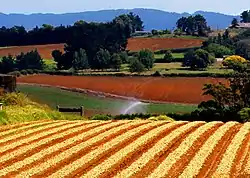Puni | |
|---|---|
 An onion field in Puni | |
| Coordinates: 37°13′59″S 174°51′20″E / 37.2330°S 174.8556°E | |
| Country | New Zealand |
| Region | Auckland Region |
| Ward | Franklin ward |
| Board | Franklin Local Board |
| Electorates | |
| Government | |
| • Territorial Authority | Auckland Council |
| Area | |
| • Total | 38.10 km2 (14.71 sq mi) |
| Population (June 2022)[2] | |
| • Total | 1,790 |
| • Density | 47/km2 (120/sq mi) |
Puni is a rural locality in the Franklin ward of Auckland in the North Island of New Zealand. It is predominantly a dairy farming and market gardening area. The main type of crops grown are potatoes, carrots, and onions.
Puni is located between the larger towns of Pukekohe and Waiuku.[3]
Demographics
Puni covers 38.19 km2 (14.75 sq mi)[1] and had an estimated population of 1,790 as of June 2022,[2] with a population density of 47 people per km2.
| Year | Pop. | ±% p.a. |
|---|---|---|
| 2006 | 1,461 | — |
| 2013 | 1,530 | +0.66% |
| 2018 | 1,593 | +0.81% |
| Source: [4] | ||
Puni had a population of 1,593 at the 2018 New Zealand census, an increase of 63 people (4.1%) since the 2013 census, and an increase of 132 people (9.0%) since the 2006 census. There were 480 households, comprising 831 males and 765 females, giving a sex ratio of 1.09 males per female. The median age was 41.0 years (compared with 37.4 years nationally), with 321 people (20.2%) aged under 15 years, 315 (19.8%) aged 15 to 29, 723 (45.4%) aged 30 to 64, and 234 (14.7%) aged 65 or older.
Ethnicities were 75.7% European/Pākehā, 13.4% Māori, 5.5% Pacific peoples, 14.9% Asian, and 2.4% other ethnicities. People may identify with more than one ethnicity.
The percentage of people born overseas was 18.8, compared with 27.1% nationally.
Although some people chose not to answer the census's question about religious affiliation, 51.0% had no religion, 36.2% were Christian, 1.5% had Māori religious beliefs, 3.2% were Hindu, 0.4% were Muslim, 0.6% were Buddhist and 2.6% had other religions.
Of those at least 15 years old, 186 (14.6%) people had a bachelor's or higher degree, and 246 (19.3%) people had no formal qualifications. The median income was $36,100, compared with $31,800 nationally. 249 people (19.6%) earned over $70,000 compared to 17.2% nationally. The employment status of those at least 15 was that 732 (57.5%) people were employed full-time, 201 (15.8%) were part-time, and 27 (2.1%) were unemployed.[4]
Education
Puni School is a contributing primary school (years 1–6) with a roll of 230.[5] The school was founded in 1878.[6]
Mauku School is a contributing primary school (years 1–6) with a roll of 158.[7] It is a little more than 4 km northwest of Puni School, and was opened in 1883.[8]
Both schools are coeducational. Rolls are as of April 2023.[9]
References
- 1 2 "ArcGIS Web Application". statsnz.maps.arcgis.com. Retrieved 21 August 2022.
- 1 2 "Population estimate tables - NZ.Stat". Statistics New Zealand. Retrieved 25 October 2022.
- ↑ Bradley, Barry (1999). The Penguin New Zealand Atlas. Penguin Books. ISBN 0140289143.
- 1 2 "Statistical area 1 dataset for 2018 Census". Statistics New Zealand. March 2020. Puni (165000). 2018 Census place summary: Puni
- ↑ Education Counts: Puni School
- ↑ "Puni school memorials". Ministry for Culture and Heritage. 17 February 2017.
- ↑ Education Counts: Mauki School
- ↑ "Collections record: Not self but service : Mauku School centenary, 1883-1983, 14th-16th October 1983. The history of the Mauku School and the district". Auckland Museum. Retrieved 25 September 2020.
- ↑ "New Zealand Schools Directory". New Zealand Ministry of Education. Retrieved 12 December 2022.